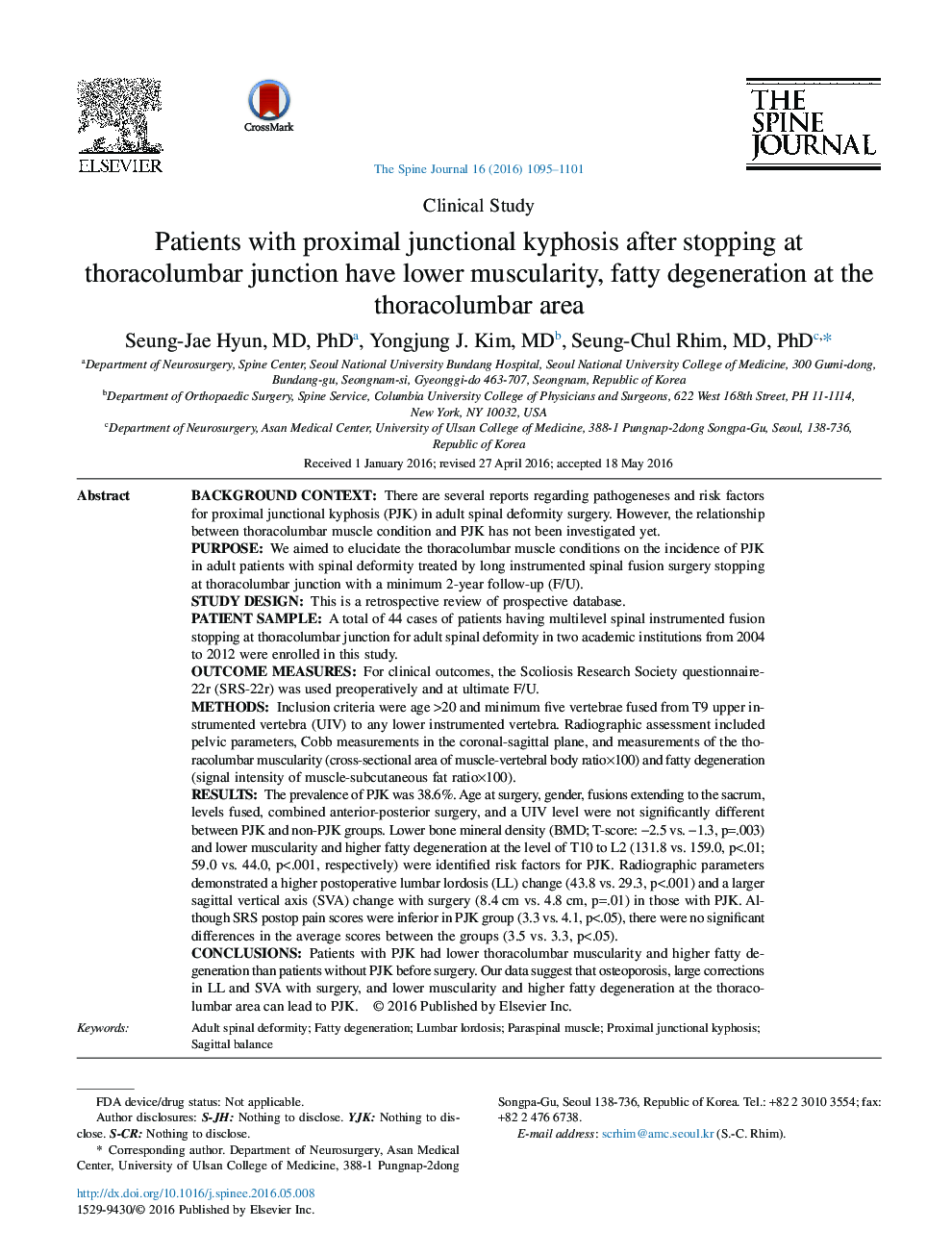| کد مقاله | کد نشریه | سال انتشار | مقاله انگلیسی | نسخه تمام متن |
|---|---|---|---|---|
| 4095729 | 1410993 | 2016 | 7 صفحه PDF | دانلود رایگان |
Background ContextThere are several reports regarding pathogeneses and risk factors for proximal junctional kyphosis (PJK) in adult spinal deformity surgery. However, the relationship between thoracolumbar muscle condition and PJK has not been investigated yet.PurposeWe aimed to elucidate the thoracolumbar muscle conditions on the incidence of PJK in adult patients with spinal deformity treated by long instrumented spinal fusion surgery stopping at thoracolumbar junction with a minimum 2-year follow-up (F/U).Study DesignThis is a retrospective review of prospective database.Patient SampleA total of 44 cases of patients having multilevel spinal instrumented fusion stopping at thoracolumbar junction for adult spinal deformity in two academic institutions from 2004 to 2012 were enrolled in this study.Outcome MeasuresFor clinical outcomes, the Scoliosis Research Society questionnaire-22r (SRS-22r) was used preoperatively and at ultimate F/U.MethodsInclusion criteria were age >20 and minimum five vertebrae fused from T9 upper instrumented vertebra (UIV) to any lower instrumented vertebra. Radiographic assessment included pelvic parameters, Cobb measurements in the coronal-sagittal plane, and measurements of the thoracolumbar muscularity (cross-sectional area of muscle-vertebral body ratio×100) and fatty degeneration (signal intensity of muscle-subcutaneous fat ratio×100).ResultsThe prevalence of PJK was 38.6%. Age at surgery, gender, fusions extending to the sacrum, levels fused, combined anterior-posterior surgery, and a UIV level were not significantly different between PJK and non-PJK groups. Lower bone mineral density (BMD; T-score: −2.5 vs. −1.3, p=.003) and lower muscularity and higher fatty degeneration at the level of T10 to L2 (131.8 vs. 159.0, p<.01; 59.0 vs. 44.0, p<.001, respectively) were identified risk factors for PJK. Radiographic parameters demonstrated a higher postoperative lumbar lordosis (LL) change (43.8 vs. 29.3, p<.001) and a larger sagittal vertical axis (SVA) change with surgery (8.4 cm vs. 4.8 cm, p=.01) in those with PJK. Although SRS postop pain scores were inferior in PJK group (3.3 vs. 4.1, p<.05), there were no significant differences in the average scores between the groups (3.5 vs. 3.3, p<.05).ConclusionsPatients with PJK had lower thoracolumbar muscularity and higher fatty degeneration than patients without PJK before surgery. Our data suggest that osteoporosis, large corrections in LL and SVA with surgery, and lower muscularity and higher fatty degeneration at the thoracolumbar area can lead to PJK.
Journal: The Spine Journal - Volume 16, Issue 9, September 2016, Pages 1095–1101
